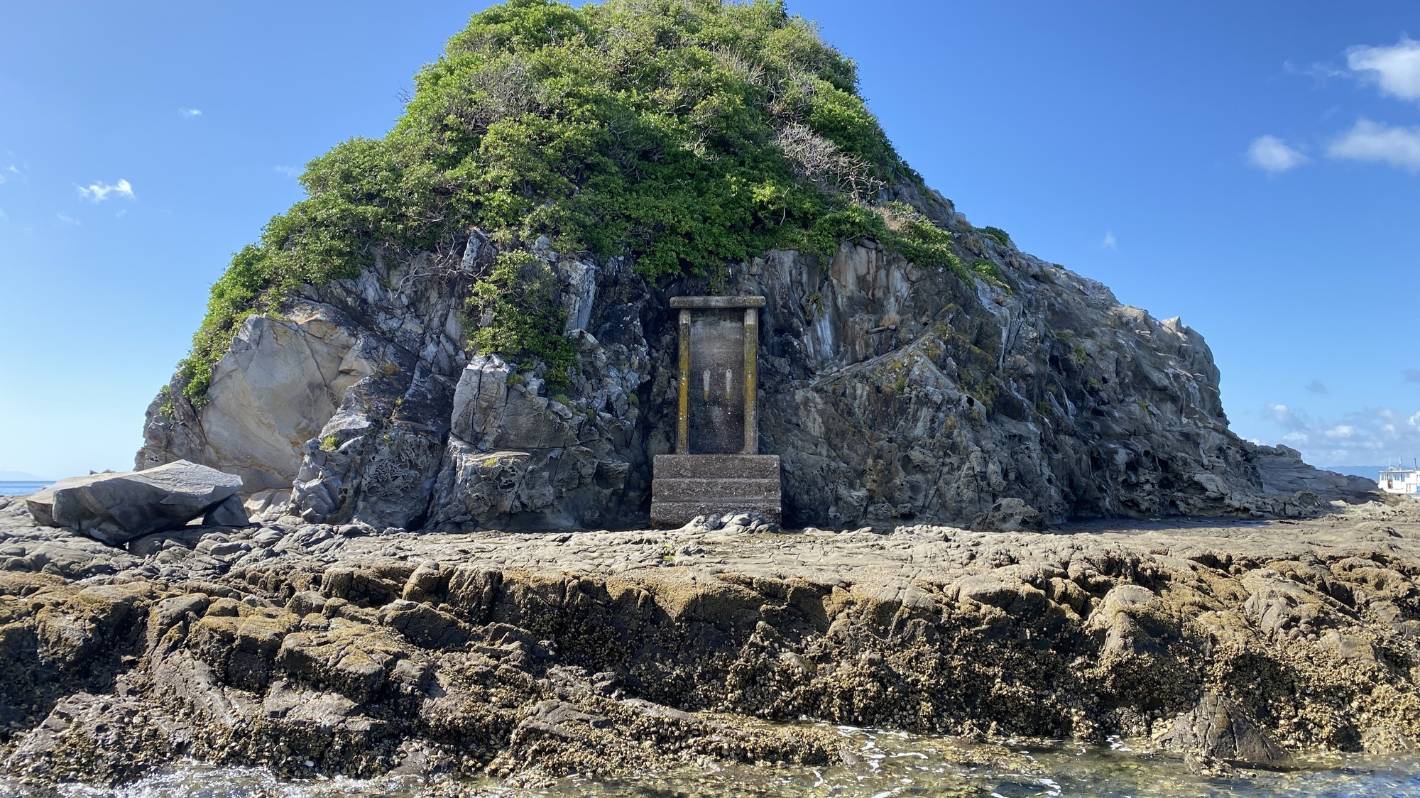At the entrance to Whangārei Harbour, a small, rocky island called The Frenchman has a mysterious concreted door. Denise Piper finds its history is not as clear as the waters surrounding it.
At first glance, Frenchman Island is not particularly exciting.
A small outcrop with a smattering of bushes holding onto its steep, rocky outline, the island at the entrance to Whangārei Harbour is best known for its fishing and shark encounters.
But if you get close to The Frenchman – named because it looks like a French soldier’s helmet – you can see a strange doorway, sealed with concrete, including rounded pillars and three concrete steps.
READ MORE:
* Fishing friends encounter great white shark near Frenchman Island, Whangarei Heads
* The Glasshouse: Northland’s private retreat offers a once-in-a-lifetime experience
* More doors or wheels? Rugby ref’s head-scratcher sets Twitter aflutter
Denise Piper/Stuff
Frenchman Island in Whangārei Harbour has a mysterious sealed doorway.
Just what this door is, or was, is a mystery, but the island and its picturesque surroundings have a fascinating history.
The Frenchman, along with eight other Whangārei Harbour islands, was sold by Ngāti Kahu in 1864 to Queen Victoria for the princely sum of £20.
The island remains in Crown ownership, under the management of Northland Regional Council, which took over the responsibilities of Northland Harbour Board.
Unfortunately, harbourmaster Jim Lyle said he knew nothing about a door on the island.
Internet rumours suggest the door is related to the area’s 19th century smuggling past, when cargo with high excise costs, like tobacco and whisky, was stowed away at nearby Smugglers Bay.
A Frenchman associated with the smugglers lived inside the island and if he saw the excise men nearby, he would light a smokey fire to alert lookouts above Smugglers Bay, according to blogger The Curmudgeon.
Denise Piper/Stuff
The Frenchman, so-called because it looks like a French soldier’s helmet, can be accessed by boat or a walk from Urquharts Bay and a short swim in shark-infested waters.
The smuggling itself is recorded, with W.R. Vallance writing in The History of Whangarei Heads that magistrate and customs collector Harcourt Richard Aubrey had a revenue cutter that roamed the coast in the 1860s.
Locally-owned schooners made considerable trade with the islands of the Pacific – including importing whisky from New Caledonia – and kept a lookout for the revenue boat, the book said.
“If no sign of the ‘government boat’ was seen in Bream Bay, a quick visit was made to Smugglers’ Cove, cases of whisky smartly landed and buried in the sand.”
Just where the lookout was kept is not clear but a member of Waipū Museum’s genealogy and research team said Frenchman Island was not involved in Waipū’s whisky still events which gave Smugglers Bay its name.
Denise Piper/Stuff
Just around the corner from The Frenchman is Smugglers Bay, where liquor was stowed to avoid hefty tax.
A search through historic papers shows The Frenchman was the site of the first navigation light in Whangārei Harbour, with the island being chosen over nearby Busby Head after months of argument.
Whangarei Harbour Board officially lit the acetone light in January 1913, according to Northern Advocate coverage.
Nearby Home Point is also the site of a significant World War II gun emplacement, made in very similar concrete to the door on The Frenchman.
The gun emplacement, battery observation post, engine room, accommodation and services were built in 1942, according to the Department of Conservation, which now manages the Bream Head Scenic Reserve.
Denise Piper/Stuff
Just ashore from The Frenchman is a World War II gun emplacement overlooking the harbour entrance.
Still accessible only by foot, it has distinct features, including a nationally-significant military mural of Whangārei Harbour, painted to help those directing fire to quickly estimate the bearing of a sighting.
The area was also the site of a famous gold recovery, along with a little-known war tragedy.
On June 13, 1940, German ship Orion laid numerous mines off Bream Head.
One of the first tragedies was Pacific liner RMS Niagara, which struck a mine during passage between Auckland and Suva on June 19, 1940.
There was no loss of life but the ship was sunk with gold ingots worth £2.5 million, equivalent to nearly $250m today.
In late 1941, a remarkable salvage effort recovered almost all the gold from the wreck, which lay at 110m deep.
The History of Whangārei Heads records the salvage effort was done aboard steamer Claymore, which was based at Urquharts Bay and used a diving bell.
Unfortunately, another of the same mines led to tragedy for New Zealand mine sweeper HMS Puriri, which sunk off Bream Head on May 14, 1941.
Denise Piper/Stuff
The doorway on Frenchman Island is set into the rocks. On the day Stuff visited conditions were too rough to go ashore.
Five lives were lost in the incident; the only casualties suffered in New Zealand waters as a direct result of enemy action, according to Whangarei Leader reports in 2011.
The incident was subject to wartime censorship and never widely published, until a memorial was built at Ocean Beach in 2011.
But while the wartime history seems a likely explanation for The Frenchman’s door the Defence Force has no record of it, nor any link to the gun emplacement.
“Unfortunately, this door doesn’t feature in any of our current or historic data sets, nor in any LINZ maps,” a spokesperson said.
The door is also not noted in a 1984 archaeological survey of Whangārei Harbour, done by Northland Harbour Board.
So the door – if it ever was a door – remains a mystery still waiting to be unlocked.
Do you know more about The Frenchman’s door? Contact denise.piper@stuff.co.nz with information.



